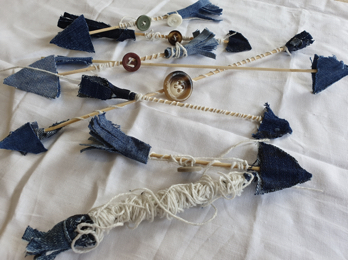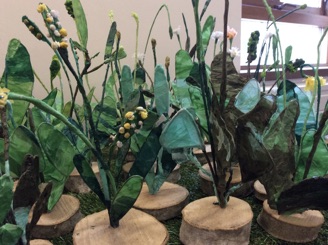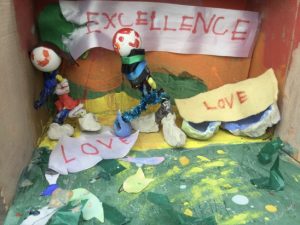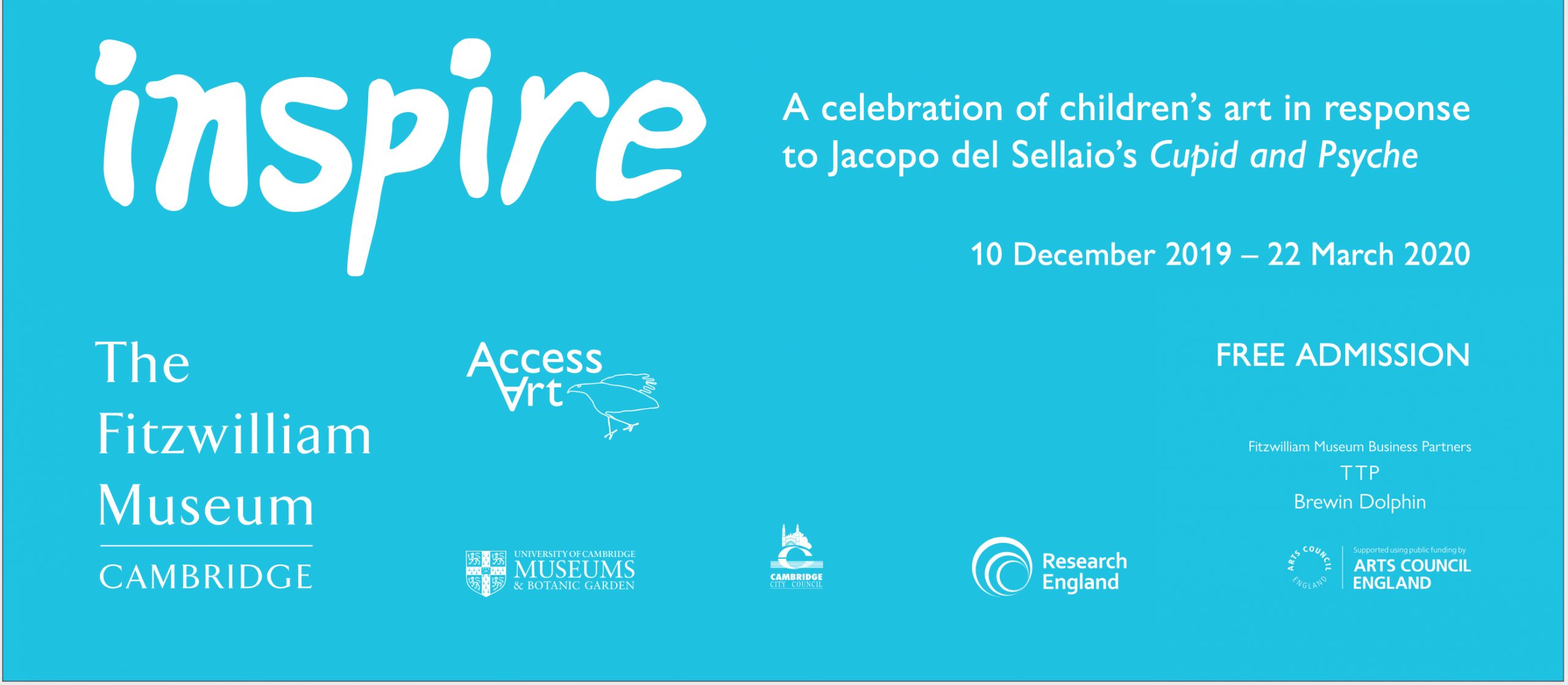Cupid and Psyche: How a Fifteenth-Century Renaissance Panel Became the Most Loved Painting in Cambridgeshire
In December 2018 Miranda Stearn, Head of Education at the Fitzwilliam Museum, Cambridge, sent a letter drafted by Kate Noble, Education Officer at the Museum, and Sheila Ceccarelli of AccessArt, to all the Primary school headteachers in Cambridgeshire, declaring a ‘state of emergency in the teaching of Art’ in state-funded Cambridgeshire schools.
Based on the National Gallery’s Take One Picture, a focus painting Cupid and Psyche by Jacopo Del Sellaio from the Fitzwilliam Museum’s collection was chosen to be the centre of an ambitious project, Inspire 2020, aiming to reinforce and energise the teaching of Art in local primary schools.

The idea for the project came about during a conversation in a cafe between Kate and Sheila with Katherine Woodard, a local teacher who suggested that teachers were in need of a creative boost and schools were in need of a celebration of their children’s artwork.
In response, the Museum invited teachers for a free, all-day CPD (Continued Professional Development), at the Fitzwilliam Museum led by the Fitzwilliam Museum Education Team and AccessArt and invited schools to enter pieces into an exhibition of children’s artwork Inspire, in the prestigious Octagon Gallery (Gallery 10), at the heart of the museum, in December the following year.
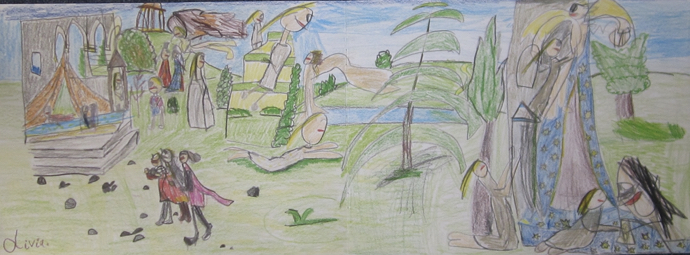
During the CPD sessions, teachers were able to learn more about Del Sellaio’s Cupid and Psyche and the time and place it was painted. The contextual elements of the sessions were led by Kate, with the support of Holly Morrison and gave teachers the opportunity to make their own observations and examine how the painting might be shown to, and interpreted by children. They also examined how it might be used for learning across already existing school curriculums and subjects.
Joanne Neville and Rowan Frame from the Hamilton Kerr Institute showed teachers how they had reconstructed a Renaissance panel by the same painter.
Sheila, from AccessArt, with the support of Museum’s studio artist, Alison Ayres, introduced teachers to sketchbooks, drawing, and collage to support the visual exploration of the panel, followed by a practical session introducing teachers to 3D processes and materials and making collages on a larger scale. Teachers were also given the opportunity to explore a variety of colour mediums and experiment with painting with egg tempera on their own wooden panels.
Teachers were invited to bring their pupils to the Museum to see Cupid and Psyche in the real and encouraged to allow the resulting Inspire 2020 projects to be led by the children themselves and the final outcomes not to be prescribed from the onset.
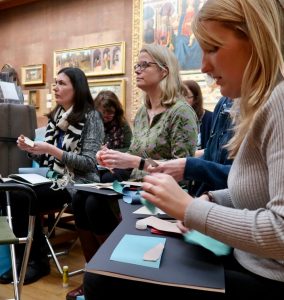
Never could we have imagined that the Inspire 2020 Project would be the success that it has been – that the teachers who came to the training sessions would go back to their respective schools and a further 110 teachers would participate; That schools would come to the museum from across the county to see the painting brought to life by museum educators, Kate, and Holly with storytelling and props, and that ultimately 3874 primary school children would be inspired to express themselves in the visual arts, resulting in 30 schools entering children’s work to be celebrated in Inspire, the exhibition, opening to the public on the 10th December 2019 (and running until 22nd March 2020).
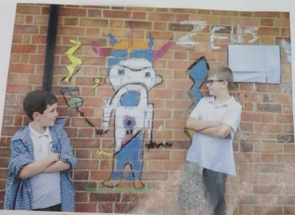
‘I am most happy with ‘the floating ground’ because it looks like it has been lifted by the energy’ Bartosz age 9
‘I am most happy with the helmet as it has more colours and it is bold so everyone who looks at it will notice it.’ Toby age 9
Extraordinarily, at the centre of this project is a Rennaissance panel, possibly the least likely candidate to inspire so many primary school children, but which has arguably now become the most greatly loved and known painting by children locally, not least because it depicts the very story of love, Cupid and Psyche. This panel was painted by the 15-century Florentine artist Jacopo Del Sellaio and was originally painted as part of a wedding chest or ‘casone’ for a wealthy Rennaisance family.
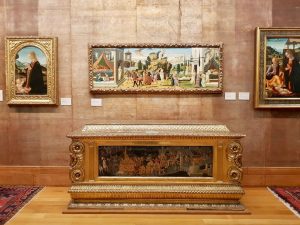
Here’s a wager! Ask a child you know, aged 4 to 11, from Haddenham and Bottisham, in the East, Great Gidding in the North, Linton Heights in the South, from Arbury to Willingham, to recount the story of Cupid of Psyche, and I bet you they will! They’ll embellish it and tell you about all the characters with anecdotes from stories they know. They’ll, no doubt describe classical buildings in a lush, Mediterranean landscape, scattered in trees and in the distance they’ll tell you about a temple to Apollo and describe Psyche’s bower, the bed of flowers on which she sleeps. They’ll tell you about Psyche’s resilience and maybe even tell you about the devastating betrayal and jealousies that she endured, and the anguished face of love torn Cupid! They’ll compare the story with popular fairy tales like Beauty and the Beast, and ‘sequential narrative’ like in a Beano comic. They will declare ‘Love wins!’
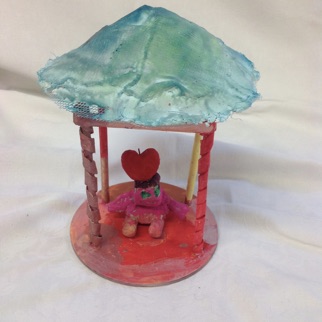
Don’t be surprised when they tell you in great detail how it was painted by an Italian painter, in Florence, called Jacopo Del Sellaio who rendered the story on a panel made of poplar, which was carefully prepared with gesso (by a team of apprentices!) and painted with egg used to bind precious and carefully prepared pigments. They will tell you about the gold gilding that he used to embellish his finished work. That the painting formed part of a wedding chest where children would be able to study the story in the marital suite and learn about all the virtues of marriage and trust!
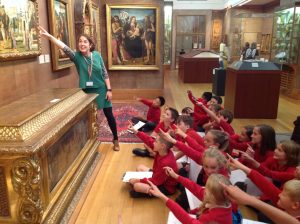
This is the prize for having given the children the opportunity to sit with the painting in the real and with the guidance of the education team taking them on a journey of ‘deep looking’. The museum trips clearly bought the painting to life and opened the children’s imaginations. Children were encouraged to make their own observations and take their new-found knowledge, armed with their own imaginations back to their schools to embark on a journey of research, experimentation, and play.
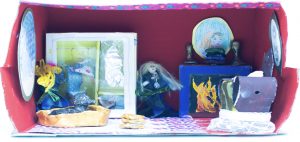
Schools entered the project in whatever capacity they could and they were encouraged to make the project work for them, around their own school day and with the groups of children they felt most able to support. Some schools embarked on the project as a whole school and others selected small groups of targeted children. Some schools had Art visibly integrated into their every school routines, whereas others were at the beginning of their creative journey.
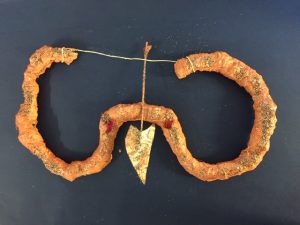
In this project, teachers listened, like the Year One teacher, Anna Shepherd at William Westly, who facilitated a trip from the Raptor Centre after a pupil observed one of Psyche’s suitor’s falconry. This took the whole Year Four class down a path of inquiry and together they produced a gorgeous collection of drawings from the real, and beautiful paintings of birds of prey; Like Del Sellaio, painted on wooden panels.
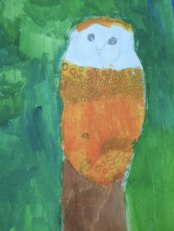
Or a group of year five children who were facilitated by Natalie Bailey from St Peter’s Juniors, to create Psyche’s dress, beautifully crafted in denim, their choice of fabric to represent ‘resilience’.
Or the teacher at Kings Hedges who listened to her children’s request for their individual flowers not to be separated and to remain an intact installation, in anticipation of Psyche sleeping on it.
One thing that is affirmed by this project is that Cambridgeshire schools and teachers care deeply about their children’s creativity and will go out of their way to harness quality opportunities available to enhance it. Teachers are often working in hugely time-pressured environments and are constrained by space and resources and often working in isolation.
This project has given teachers a chance to reflect on the skills that children need to express themselves creatively going forward in life and provide opportunities for them to use drawing, collage, and sketchbooks as tools for experimentation and research.
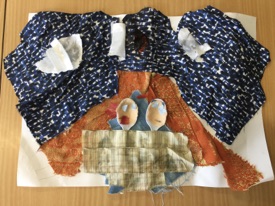
Some schools demonstrated clearly how Art can be used to enhance other areas of the curriculum including Literacy, Science, Maths and PHSE (Personal, Social and Health Education).
Like this school in Hauxton where Art and Science met for Years One and Two when children set out to carry out an investigation with a local scientist, Professor John Love to find out what colour light plants grow best under, followed by lots of drawing of plants and leaves.
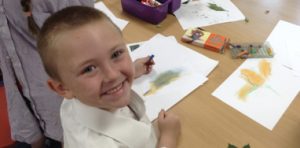
Or this school in Harston and Newton where ‘the children considered different ways that love could be represented for them’ in 3D with wire.
“From this project, I learned love doesn’t mean just showing love hearts in it. It could show the world, holding a pet, hugging a sad person.” George, 7
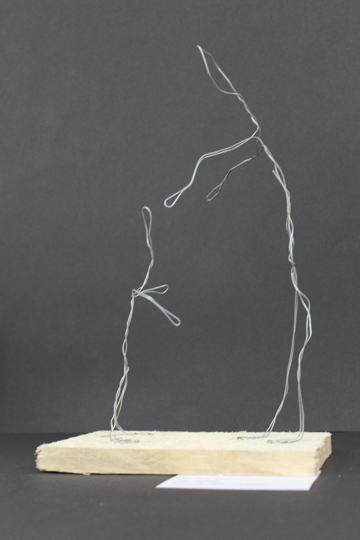
Schools, like Bottisham, showed great competence in teaching art and demonstrated visible progression in their children’s artistic skills throughout the year groups developing their observational and drawing skills and building up knowledge of mediums.

By year four, children were able to express themselves imaginatively with great artistic skill.
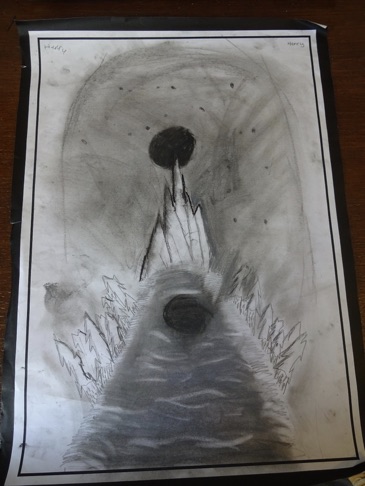
“My picture is based on the mountain Cupid was brought to in the story. When I was experimenting with coal and granite for the lake I noticed I could blend them together. When I was doing the lakes perspective I struggled a lot but I was doing it from the bottom looking up. Next I did the trees, it was hard to get the right size but I did it! Then I did the mountain as the centrepiece and shaded them. Last I did the sky and blended the two together” Henry
Other schools demonstrated an openness to play and for experimentation with lots of materials and mediums.
‘My story is about puppets finding a chest and inside they find a purse. I enjoyed making my background. What I like about my puppets is I like their bodies. To improve my work I could use my imagination more. I have learnt to experiment with materials’. Daniel age 7
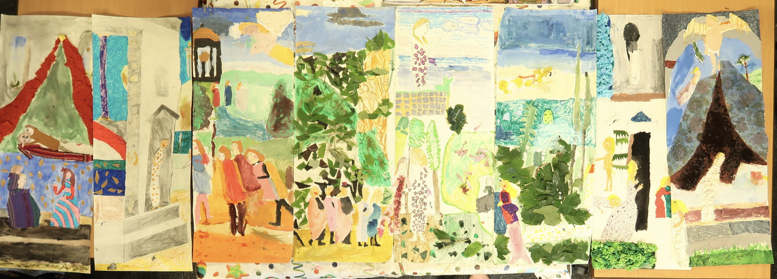
Children have worked collaboratively, learning together, or mastered skills with their own personal exploration.
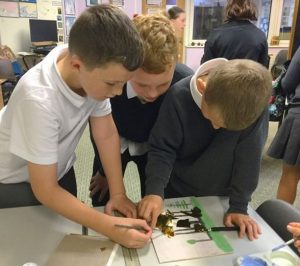
We’ve seen schools come together as a creative community and engage members beyond their staff and pupils.
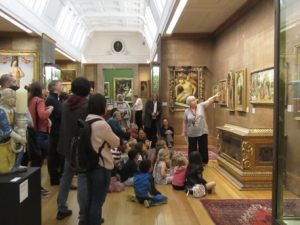
We’ve seen older children mentoring younger ones, teachers training teachers, and a wealth of sharing ideas and knowledge.
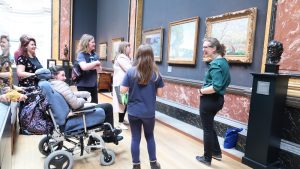
And work together to celebrate their whole school like pupils at St Laurence Catholic School, Cambridge under the guidance of their teachers, Lisa Bairos, who worked hard to create ‘From the Fruits of Our Learning’ an ambitious whole school project inspired by Cupid and Psyche to tell the story of the first fifty years of their school story.
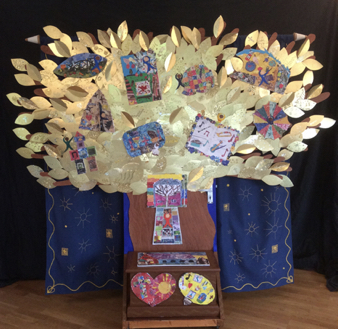
Schools have had their own celebrations and we’ve seen photographs of assemblies across the county where children have had a chance to show off their beautiful achievements.
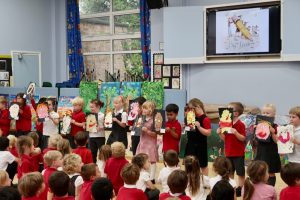
Inspire 2020, is a project which demonstrates how much art is valued by our Cambridgeshire schools and community and that working together we can create real and meaningful educational opportunities for our children. This is an example of how a museum education team exercised its privileged position of being respected and integrated in a prestigious setting, to positively and genuinely support schools. This project would not have been possible without the Museum’s director, Luke Syson and head of education, Miranda Stearn be firmly being behind it and seeing the importance of having children and schools at the heart of the museum’s participation programme.
It has been an immense privilege for AccessArt to be able to work so closely with the Fitzwilliam Education Team to deliver this project and work closely with teachers from Cambridgeshire schools.
We hope that Inspire 2020 Project demonstrates the value of teaching pupils practical fine-art skills from drawing and sketchbooks to making, from full-colour immersion to large scale cutting and collage. That children have the right to access all the experiences they need to feel entitled to produce reflective artworks and have the tools to use creativity to enhance their whole learning and to express themselves creatively throughout their lives.
With special thanks to these primary schools in Cambridgeshire for so energetically participating in the Inspire 2020 Project:
Arbury Primary School, Bottisham Primary School, Cheveley C of E Primary School, Great and Little Shelford C of E Primary School, Great Giddings C of E Primary School, Harston and Newton Community Primary School, Haslingfield Endowed Primary School, Hauxton Primary School, Heritage School, Histon and Impington Junior School, Houghton Primary School, Kings Hedges Primary School, Linton Heights Junior School, Mayfield Primary School, Milton Road Primary School, Morley Memorial Primary School, Peckover Primary School, Robert Arkenstall Primary School, Samuel Pepys School, St Laurence’s Catholic Primary School, St Peters, Stamford School, Stapleford Community Primary School, Thorndown Primary School, Thriplow C of E Primary School, Cambridge University Primary School, The Vine Interchurch Primary School, Wheatfields Primary School, Wilburton C of E Primary School, William Westley C of E Primary School, Willingham Primary School
Inspire – December 2019 to March 2020, was an exhibition of art made by primary school children and celebrated creativity in Cambridgeshire schools. It championed the on-going importance of cultural learning and the visual arts for all children and young people.
Based on the National Gallery’s Take One Picture, The Fitzwilliam Museum and AccessArt teamed together to offer free Inspire 2020 CPD (Continued Professional Development for Teachers), focusing on one painting, Cupid and Psyche by Jacopo del Sellaio, as a source of ideas and inspiration.
Del Sellaio’s Cupid and Psyche was on display next to the children’s work in the Octagon Gallery.
With very special thanks to Kate Noble, Miranda Stearn, Sarah Villis, and Holly Morrison for making this project happen and Alison Ayres.
This post was written by Sheila Ceccarelli. Images published with thanks to the participating schools.

